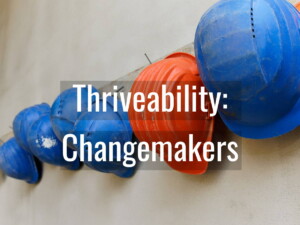Tourism’s thriveability requires performative change: Foundations

What are the basic requirements for tourism destinations to thrive? K Michael Haywood lays them out in this “Good Tourism” Insight.
[You too can write a “GT” Insight.]
These days, anxieties are running high. Our ability to thrive is under threat.
Permacrises are wreaking havoc:
- Democracies and our freedoms are under attack.
- Cancel culture and food insecurities are on the rise.
- Rampant inflation is dampening economic prosperity.
- Societies are becoming polarised and angry.
- Incivility and ultra-nationalism are driving hate and racism.
- Pandemics and climatic events are now catastrophic.
No wonder so many companies, communities, and countries are adrift; others lost in their divisiveness and dis-ease.
While a large number of sustainability, regenerative, and ameliorating initiatives are underway, the fertile conditions for life — and the well-being of eco-systems, organisations, and humanity — remain in need of revitalisation.
Are we really saving ourselves? Prepped? Could it be that the self-organising properties of living systems are in abeyance? I wonder.
Read “GT” posts tagged with “Risk and crisis management”
There can be no doubt: We’re on the cusp of a new era.
Why, then, isn’t power being properly marshalled and managed; awareness about shifting paradigms increasing; and, science being taken seriously?
Post-pandemic, tourism in communities-as-destination may be on the rebound, but economic revival will not address or resolve these and related concerns. In fact, the opposite is likely to occur as operators maximise growth utilising routine behaviours, policies, and practices antithetical with the complexities of today’s social movements.
Reformation, however, is possible.
What follows are some basic requirements for tourism’s thriveability.
The basic requirements for tourism’s thriveability
There can be no doubt, sustainable tourism counts for development through which the mundanity of economics will continue to rank highly.
Fortunately, far more is at stake as communities-as-destinations become revisionist, especially in their search for enhanced meaning and livability; their longing for improved quality-of-life and ‘wellth’ designed to enhance the lives of all.
Read other “GT” posts tagged with “Community-based tourism”
Success in achieving such outcomes, however, cannot begin until the “why” of communities-as-destinations, not simply tourism, is known and fleshed out. It’s an inquiry intended to culminate in clarity of purpose demanding activation.
The intent: To achieve more liberating forms of self-actualisation, the good life, and civic pride; fundamental requirements leading to tourism becoming acknowledged as an honourable and legitimate super-cluster.
While enactment could be contentious, it needn’t be, so long as communities-as-destinations seek to:
- Resolve the antagonism and mistrust among stakeholders;
- Consolidate the goals of communities, organisations, NGOs and citizens to create what might be termed a solidarity dividend;
- Advocate and assume responsibility for pursuit of the common or greater good;
- Embrace the ethics and aesthetics of care, the basis for ‘inspired hospitality’, ‘comprehensive sustainability’, and ‘shared value’.
- Invest in, and enhance, the magnificence of our world’s unique human, cultural, and natural resources; requiring far-reaching place-making and green transition investments, leading to more sustainable, aesthetic, and ‘compelling communities’;
- Envision travel & tourism as a primary means for not just enjoying, but protecting and improving the conditions for life, in all its forms;
- Generate localised, collective action on all sustainability and regenerative fronts;
- Promote ethical travel;
- Amplify, sensualise, but not dominate, the centres for community activity;
- Help people cope with their hardships and work through their anxieties;
- Give voice, choice, and ownership to those most affected by what communities-as-destinations do, stand for, and hope to achieve;
- Create ‘Destinations-in-Action Networks of Influence’ to help articulate and respond to pressing problems;
- End toxic behaviours in workplace cultures that account for workers’ ‘misery’ and ‘great resignations’.
Building on these foundational qualities, it’s heartening that the Sustainable Markets Initiative is seeking fundamental market transformations in favour of people and the planet. However, if that and similar initiatives (e.g. COP 27) are to be effective, tourism’s leaders, destination management and marketing organisations (DMOs), and educators will need to contextualise the details, start doing, and be held accountable.
That’s the subject of the second part of this article.
In the second part of his “Good Tourism” Insight, Prof Haywood discusses the likely changemakers — leaders, DMOs, and educators — and the actions they might take to boost tourism destinations’ capacity to thrive. Read it now: “Tourism’s thriveability requires performative change: The changemakers”.
What do you think? Share a short anecdote, comment, or question below. Or write a “GT” Insight of your own. The “Good Tourism” Blog welcomes diversity of opinion and perspective on travel & tourism because travel & tourism is everyone’s business.
Featured image (top of post): Tourism’s thriveability requires performative change: The foundations. Base image by Tom (CC0) via Pixabay.
About the author

K Michael Haywood is Professor Emeritus, School of Hospitality, Food and Tourism at the University of Guelph in Ontario, Canada. Prof Haywood has recently written an e‑book “Astonish, Smarter Tourism by Design”. Find Michael on LinkedIn.





